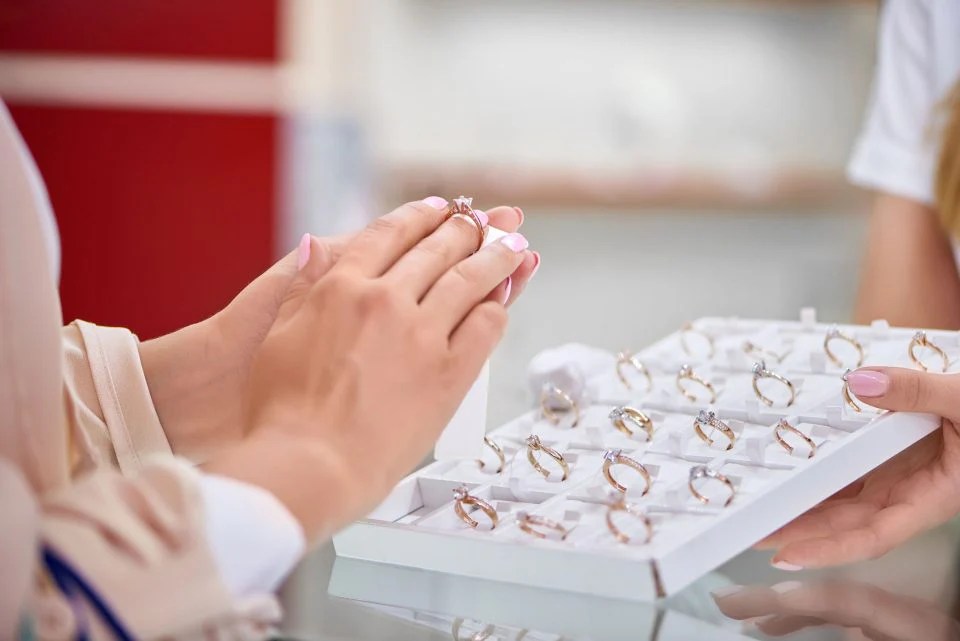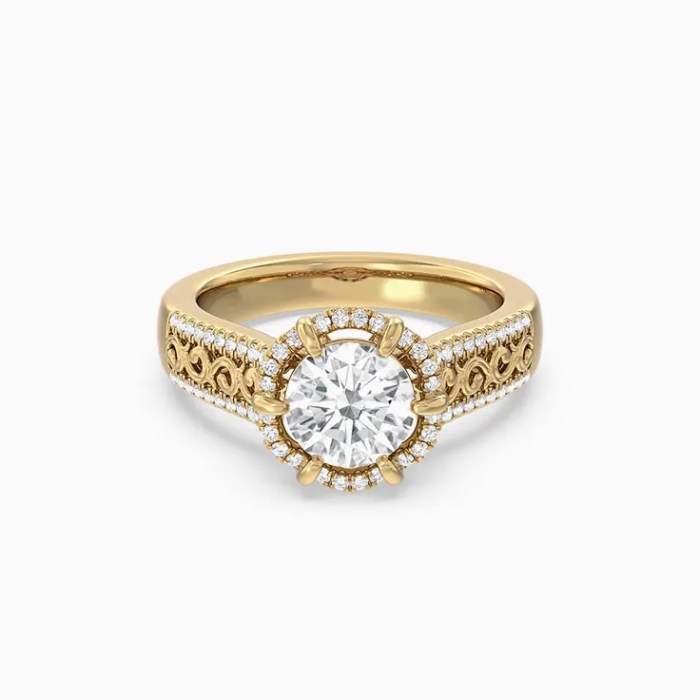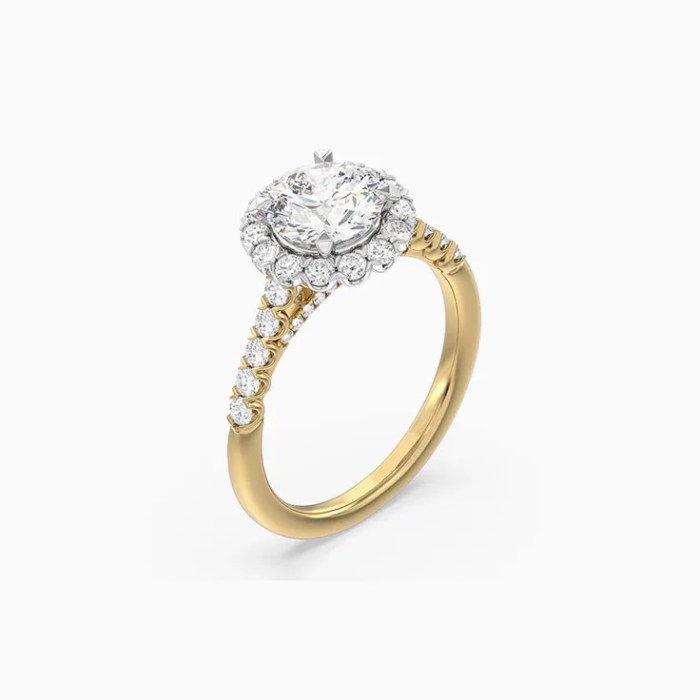Best lab grown diamond engagement rings are redefining romantic traditions with their stunning beauty and ethical allure. These diamonds, created in controlled environments, boast features that often surpass their natural counterparts, offering a brilliant choice for modern couples. With distinct grading systems and a variety of styles, lab grown diamonds cater to diverse preferences, making them an appealing option for engagement rings.
From solitaire to halo designs, the trends in lab grown diamond shapes and cuts continue to evolve, captivating brides-to-be. The affordability of these diamonds, combined with their ethical implications, positions them as a smart investment for those ready to say “yes.” In this guide, we’ll explore the various features, styles, pricing, and care tips associated with lab grown diamond engagement rings.
Popular Features of Lab Grown Diamonds: Best Lab Grown Diamond Engagement Rings

Source: diamonddomain.com
Lab grown diamonds are increasingly becoming a favored choice for engagement rings, thanks to their remarkable features and ethical advantages. These diamonds possess identical physical and chemical properties to natural diamonds, but their creation in a controlled environment sets them apart. Understanding these unique attributes, grading systems, and the benefits associated with lab grown diamonds can help couples make informed decisions during their engagement ring selection process.Lab grown diamonds are created using advanced technological processes that replicate the conditions under which natural diamonds form.
This results in stones that are virtually indistinguishable from their natural counterparts, both in appearance and quality. The most notable feature of lab grown diamonds is their sustainability; they are produced with a significantly lower environmental impact and without the ethical concerns sometimes associated with mined diamonds.
Grading Systems for Lab Grown Diamonds, Best lab grown diamond engagement rings
Understanding the grading systems used for lab grown diamonds is essential for making an informed choice. The categorization primarily follows the same criteria established for natural diamonds, known as the Four Cs: Carat, Cut, Color, and Clarity. Each of these factors hugely influences the diamond’s overall quality and value.
- Carat: This refers to the weight of the diamond. Larger carat weight typically means higher value, but it’s crucial to balance size with cut quality.
- Cut: The quality of the cut determines how well the diamond reflects light, impacting its brilliance and overall visual appeal.
- Color: Lab grown diamonds can range from colorless to shades of yellow or brown. The less color visible, the more valuable the diamond is considered.
- Clarity: This measures the presence of internal or external flaws (inclusions and blemishes). Higher clarity means fewer imperfections, which significantly increases a diamond’s beauty and value.
The significance of these grading systems lies in their ability to provide a standardized method for assessing diamond quality. Every lab grown diamond is evaluated and graded by certified gemologists, ensuring that buyers receive accurate and consistent information.
Benefits of Choosing Lab Grown Diamonds
Opting for lab grown diamonds comes with several advantages that make them an appealing choice for engagement rings. These benefits not only contribute to personal satisfaction but also reflect broader social and environmental values.
- Cost-Effective: Lab grown diamonds are generally more affordable than natural diamonds, allowing couples to maximize their budget for quality and size.
- Ethical Sourcing: Purchasing a lab grown diamond means supporting a conflict-free industry, alleviating concerns over unethical mining practices.
- Environmental Impact: Lab grown diamonds require significantly less environmental disruption compared to traditional diamond mining, appealing to environmentally conscious consumers.
- Customization Options: Many lab grown diamond retailers offer extensive customization options, allowing buyers to select specific features that reflect personal style.
The combination of these benefits makes lab grown diamonds a stylish and responsible choice for couples embarking on a lifelong commitment. As awareness of these unique features grows, lab grown diamonds are likely to become an even more popular option in the world of engagement rings.
Top Lab Grown Diamond Engagement Ring Styles

Source: vogue.com
Lab grown diamonds have taken the jewelry market by storm, and their versatility allows couples to choose from a wide array of styles and settings. These diamonds provide an ethical and often more affordable alternative to mined diamonds, without sacrificing quality or beauty. It’s essential to explore the current trends in lab grown diamond engagement rings to find the perfect style that resonates with personal aesthetics and values.When selecting a lab grown diamond engagement ring, various styles and settings come into play.
Each style offers unique characteristics and visual appeal, catering to different preferences. Below are some of the most sought-after styles for these stunning gems.
Popular Engagement Ring Settings
Understanding the different settings available can significantly enhance the overall look of the ring. Here’s a comparison of some popular settings for lab grown diamonds:
| Setting Type | Description | Best Suited For |
|---|---|---|
| Solitaire | A single diamond set alone, showcasing its brilliance and beauty. | Minimalist styles and those who prefer a classic look. |
| Halo | A central diamond surrounded by a circle of smaller diamonds, enhancing its sparkle. | Those who love extra sparkle and a vintage touch. |
| Three-Stone | Features three diamonds representing the past, present, and future of a relationship. | Sentimental couples looking to signify their journey together. |
As the market for lab grown diamonds continues to evolve, certain styles and cuts are gaining traction among engaged couples.
Trends in Diamond Shapes and Cuts
In addition to various settings, the shape and cut of a diamond significantly influence its overall appeal. Currently, lab grown diamonds in specific shapes are trending, reflecting both timeless elegance and contemporary flair. The following shapes and cuts are particularly popular:
Round Cut
The classic choice known for its exceptional sparkle and versatility, making it ideal for various settings.
Princess Cut
A modern cut that features a square shape with sharp corners, appealing to those who prefer a more contemporary look.
Oval Cut
This shape offers a unique appearance while maximizing the carat weight, creating an elongated look on the finger.
Cushion Cut
A vintage-inspired shape that combines a square with rounded corners, known for its romantic appeal.
Emerald Cut
A sophisticated rectangular shape that emphasizes clarity and showcases the diamond’s internal features.
“The right cut enhances the diamond’s brilliance and reflects its quality, making it crucial in choosing an engagement ring.”
These styles and cuts reflect the increasing demand for personalized and unique engagement rings, allowing couples to express their individuality while embracing the benefits of lab grown diamonds.
Pricing and Ethics of Lab Grown Diamonds

Source: vogue.com
Lab grown diamonds have transformed the diamond market, offering an ethical and often more affordable alternative to natural diamonds. As consumers become more conscious of both their financial and ethical choices, understanding the pricing and implications of lab grown diamonds is crucial in making an informed decision for engagement rings.The cost differences between lab grown diamonds and natural diamonds are significant.
Generally, lab grown diamonds can be 20% to 40% less expensive than their mined counterparts. This price reduction stems from the fact that lab grown diamonds are produced in a controlled environment, which eliminates the extensive mining and transportation costs associated with natural diamonds. Additionally, the growing technology and efficiency in production lead to lower overhead costs.
Cost Comparison of Lab Grown and Natural Diamonds
When considering the purchase of a diamond engagement ring, understanding the cost structure is essential. The following points Artikel the key financial aspects of lab grown versus natural diamonds:
- Initial Purchase Price: Lab grown diamonds typically range between $1,000 to $3,000 for a one-carat stone, depending on quality and specifications. In contrast, a comparable natural diamond can cost between $3,000 to $6,000.
- Resale Value: Natural diamonds tend to hold their value better over time, while lab grown diamonds may depreciate faster due to market saturation and perception. However, the gap is closing as consumers increasingly recognize the value of ethical options.
- Insurance Costs: Given the lower initial value, insuring a lab grown diamond can be less expensive than insuring a natural diamond, potentially resulting in significant savings over time.
The ethical implications of choosing lab grown diamonds are profound. Mined diamonds often contribute to environmental degradation and can be associated with human rights abuses, including labor exploitation and conflict financing. Conversely, lab grown diamonds are produced sustainably, significantly reducing environmental impact and eliminating concerns about unethical labor practices.
Ethical Considerations of Lab Grown Diamonds
The decision to choose lab grown diamonds comes with vital ethical considerations that reflect a commitment to responsible consumerism. The following points Artikel the key ethical advantages of lab grown diamonds:
- Conflict-Free Assurance: Lab grown diamonds are guaranteed to be conflict-free, meaning they do not fund wars or human rights abuses, unlike some natural diamonds.
- Environmental Sustainability: The production of lab grown diamonds has a significantly lower carbon footprint compared to mining, which can cause extensive land disruption and environmental damage.
- Transparent Sourcing: Lab grown diamonds often come with guaranteed traceability and transparency in their production process, which is not always the case with natural diamonds.
The long-term value of lab grown diamonds in the engagement ring market is an evolving topic. While historically, natural diamonds have been regarded as a symbol of lasting value, the increasing acceptance of lab grown diamonds indicates a shift in consumer values.
Long-Term Value Assessment of Lab Grown Diamonds
As the market for lab grown diamonds continues to evolve, their long-term value is being assessed in various ways. The following aspects should be considered:
- Market Growth: With the rise of environmentally and socially conscious consumers, the demand for lab grown diamonds is expected to grow, potentially increasing their perceived value over time.
- Consumer Perception: As more consumers understand the benefits of lab grown diamonds, their acceptance and demand will likely enhance their status in the jewelry market.
- Innovation in Production: Advances in technology may lead to higher-quality lab grown diamonds, further solidifying their place in the market as viable and valuable alternatives.
In summary, lab grown diamonds present a compelling option for those seeking an engagement ring that balances affordability, ethical integrity, and long-term value. As the market continues to evolve, consumers can feel confident that they are making a wise choice by opting for lab grown diamonds.
Care and Maintenance for Lab Grown Diamonds

Source: cloudinary.net
Lab grown diamonds are not only a beautiful choice for engagement rings but also require specific care and maintenance to keep them sparkling for a lifetime. Understanding the best practices for cleaning, storing, and regularly checking your lab grown diamond jewelry ensures its brilliance and longevity, allowing you to enjoy your investment for years to come.Cleaning and maintaining lab grown diamond engagement rings is essential to preserve their aesthetic appeal.
Regular cleaning can help remove dirt, oils, and other residues that accumulate over time. To keep your diamond ring looking its best, it’s beneficial to use gentle cleaning methods that won’t cause damage to the stone or the setting.
Best Practices for Cleaning and Maintaining Lab Grown Diamonds
To effectively clean your lab grown diamond and ensure its lasting shine, consider the following practices:
- Use a soft toothbrush or a lint-free cloth to gently scrub the diamond and its setting, focusing on hard-to-reach areas.
- Mix a solution of warm water and a few drops of mild dish soap. Soak your ring for about 20-30 minutes before gently brushing it.
- Rinse the ring thoroughly under warm running water to remove any soap residue and pat it dry with a soft, clean cloth.
- Avoid using harsh chemicals or ultrasonic cleaners, as they can damage the diamond’s brilliance and the integrity of the metal setting.
Tips for Storing Lab Grown Diamond Jewelry
Proper storage of your lab grown diamond jewelry is crucial in preventing scratches and damage. Consider these tips to ensure safe storage:
- Store your ring in a soft pouch or a dedicated jewelry box to prevent scratches from other jewelry pieces.
- Keep the ring away from extreme temperatures and humidity, which can affect the setting and the diamond.
- If possible, store in a separate compartment from other jewelry to minimize the risk of entanglement or impact.
Regular Checks and Maintenance Checklist for Diamond Rings
Maintaining your lab grown diamond ring involves regular inspections to ensure it remains in excellent condition. Here’s a helpful checklist:
- Check the prongs and settings every few months to ensure they are secure and not worn down.
- Inspect for any scratches or chips on the diamond itself, which could indicate the need for professional evaluation.
- Consider having your ring professionally cleaned and polished at least once a year to restore its shine and remove deeper dirt buildup.
- Keep an eye on any changes in the stone’s appearance, which may require immediate attention from a jeweler.
Regular maintenance not only enhances the beauty of your lab grown diamond ring but also protects your investment for years to come.
Last Recap

Source: cloudinary.net
In summary, best lab grown diamond engagement rings blend beauty, ethics, and value in a way that resonates with today’s conscious consumers. As you navigate your options, remember that choosing a lab grown diamond not only symbolizes love but also reflects a commitment to a more sustainable future. Whether you prefer a classic look or a contemporary twist, there’s a perfect lab grown diamond ring waiting for you.
Essential Questionnaire
What are lab grown diamonds made of?
Lab grown diamonds are created using high-pressure, high-temperature processes or chemical vapor deposition, replicating the natural diamond formation process.
Are lab grown diamonds more affordable than natural diamonds?
Yes, lab grown diamonds are typically 20-40% less expensive than natural diamonds, making them a budget-friendly option for engagement rings.
Do lab grown diamonds have the same quality as natural diamonds?
Absolutely! Lab grown diamonds have the same physical, chemical, and optical properties as natural diamonds and can be graded using the same standards.
How should I care for my lab grown diamond engagement ring?
To maintain its sparkle, you should regularly clean your lab grown diamond ring with mild soap and warm water, avoiding harsh chemicals and abrasive materials.
Can lab grown diamonds be resized?
Yes, lab grown diamond rings can be resized like natural diamond rings, but it’s best done by a professional jeweler to avoid damage.